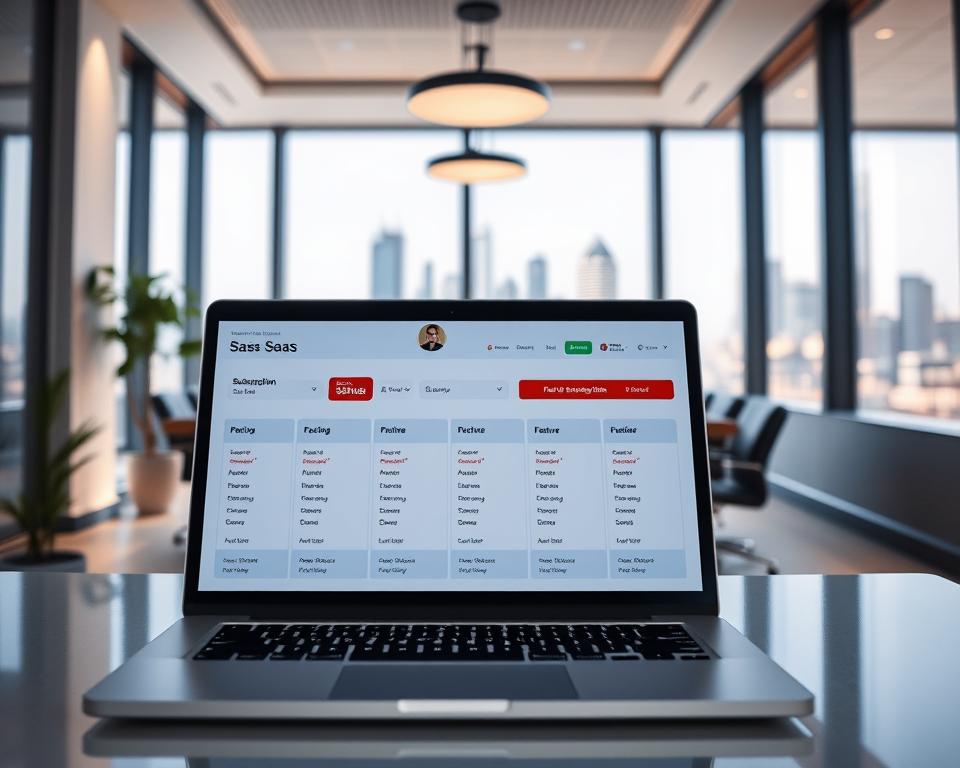Creating a successful SaaS business model needs careful planning. A good SaaS business model can bring in steady income through subscriptions. This guide will show you how to build a successful SaaS business. We’ll cover everything from creating a solid business model to building a scalable tech architecture.
To develop subscription-based software, you must know your target market well. By creating a SaaS business model that meets their needs, you can build a loyal customer base. In this guide, we’ll look at the key parts of a successful SaaS business model. We’ll talk about market research, pricing, and keeping customers happy.
Table of Contents
Key Takeaways
- Develop a solid SaaS business model to drive revenue growth
- Conduct thorough market research to understand your target audience
- Design a pricing strategy that meets the needs of your customers
- Build a scalable technical architecture to support growth
- Focus on customer retention to drive long-term success
- Continuously monitor and evaluate your SaaS business model to make data-driven decisions
Understanding the SaaS Subscription Model Landscape
The SaaS subscription model is big in the software world. It’s easy and cheap for customers. Businesses get steady income from it. Companies like Salesforce and Microsoft have grown a lot because of it.
This model helps businesses grow better. With a recurring revenue stream, they can plan better. It also means customers get more flexibility and pay less upfront.
Some big pluses of the SaaS subscription model are:
- Predictable revenue streams
- Scalability and flexibility
- Lower upfront costs for customers
- Increased customer retention
The SaaS industry is getting bigger. It’s key for businesses to know the pros and cons of this model. By using it, companies can meet the demand for software-as-a-service and make a lot of money.
Essential Components of a Successful SaaS Business Model
A successful SaaS business model needs a few key things. These include cloud-based applications and SaaS development. Together, they make a strong and growing solution for customers.
Some key parts of a SaaS business model are:
- Cloud-based infrastructure for growth and reliability
- A user-friendly interface for better customer experience
- A flexible pricing plan to fit different customer needs
By using cloud-based applications and focusing on SaaS development, companies can build a strong SaaS model. This model meets the needs of their target market.
Knowing the key parts of a successful SaaS business model helps businesses build a strong base. This drives growth and makes customers happy.
Market Research and Validation Strategies
Doing thorough market research is key for a successful SaaS app. It helps find the right market segments and understand competitors. This involves collecting data from surveys, interviews, and focus groups to know what customers want.
By understanding these needs, developers can make a SaaS app that meets customer expectations. This way, they can stay ahead of competitors and keep customers coming back.
A company can use market research to find the best pricing for their SaaS app. They can look at what competitors charge and ask potential customers for their opinions. This helps set a price that’s competitive and attractive to their target market, boosting customer retention.
- Identifying target market segments and creating buyer personas
- Analyzing competitors and their strengths and weaknesses
- Validating business ideas through feedback and testing
By using these strategies, developers can make a SaaS app that really meets customer needs. This leads to better customer retention and success in the market.
Designing Your Pricing Strategy
A good pricing strategy is key for a SaaS business to grow. It affects how much money you make and how many customers you get. To make a great pricing strategy, think about what your product offers, who you’re selling to, and who else is selling similar things. Knowing what your customers are willing to pay is very important.
When you’re setting your prices, keep these things in mind:
- Cost structure: Figure out how much it costs to make and support your product.
- Target market: Find out who your best customers are and how much they’re willing to pay.
- Competition: Look at what your competitors charge and price your product to stay competitive.
A pricing plan that balances making money with keeping customers is important. You might offer different prices, discounts, or special deals to attract and keep customers. This way, you can make more money and stay ahead in the market.
In the end, a smart pricing strategy is crucial for growing your revenue and succeeding in the SaaS world. By thinking about the important factors and making a pricing plan that fits your market, you can build a strong business. This will help you grow in a steady and lasting way.
Technical Architecture Planning for SaaS Applications
Building a SaaS application needs a solid technical architecture. It’s like building a strong base for your app to grow. Choosing the right tech stack is key. This includes picking the best programming languages, frameworks, and databases.
The tech stack affects your app’s performance, how easy it is to maintain, and its cost. A cloud-based infrastructure is often the best choice for SaaS apps. It’s scalable, flexible, and cost-effective. This lets developers focus on the app’s core features, not the infrastructure.
Key Considerations for Technical Architecture
- Scalability: The ability to handle increased traffic and user growth without compromising performance.
- Security: Implementing robust security measures to protect user data and prevent unauthorized access.
- Load Balancing: Distributing traffic across multiple servers to ensure efficient resource utilization.
- Caching: Storing frequently accessed data in memory to reduce database queries and improve response times.
- Backup and Recovery: Implementing regular backups and disaster recovery procedures to ensure business continuity.
By planning your technical architecture well, you can build a scalable, secure, and fast SaaS app. This foundation helps you focus on adding new features and improving user experience. This leads to business growth and success.
User Experience and Interface Design Principles
Creating a successful SaaS app needs careful thought on user experience and interface design. A good interface can greatly improve user engagement and keep them coming back. To make an effective interface, focus on simplicity, consistency, and feedback. These are key to designing an interface that meets your target market’s needs.
A great user experience is vital for your SaaS app’s success. To get there, make sure your interface design is intuitive and simple to use. Here are some important points to consider:
- Wireframing: Make a basic visual of your app’s layout and how it works.
- Prototyping: Build a working prototype to test and improve your app’s interface.
- Usability testing: Test your app with real users to find and fix any interface issues.
By sticking to these principles and thinking about your target market’s needs, you can make a SaaS app with a top-notch user experience. A well-designed interface design will help you build a loyal user base and achieve long-term success.
Building a Subscription-Based SaaS App: Core Development Phases
Creating a successful SaaS app starts with a solid plan. The key steps include making a minimum viable product (MVP), deciding which features to include, and figuring out how to integrate them. Using an agile approach helps developers make a roadmap that can change as needed.
The first step is to build an MVP. This means identifying the most essential features and starting with those. It lets developers test the app with a few users and get feedback. This is a big part of agile, as it helps improve the app over time.
After the MVP is ready, it’s time to add more features. This involves assessing the needs of the target market and picking the most important features. An agile approach lets developers respond quickly to changing market conditions and keep the app relevant.
- Define the MVP and its key features
- Prioritize features based on market needs
- Integrate features into the app using an agile methodology
By following these steps, developers can make a SaaS app that meets its users’ needs. Using agile and focusing on market needs makes the app flexible, adaptable, and responsive to changes.
Implementation of Subscription Management Systems
Effective subscription management is key for a SaaS business to thrive. It covers managing subscriptions, handling payments, and ensuring a smooth user experience. A good subscription system can lower churn rates, boost revenue, and make customers happier.
When setting up a subscription system, picking the right payment gateway is vital. You need a payment gateway that can handle recurring payments, send invoices, and notify customers. Stripe, PayPal, and Authorize.net are some top choices.
What makes a subscription system great includes:
- Recurring billing and invoicing
- Automated payment reminders and notifications
- Customer portal for self-service and account management
- Integration with popular payment gateways
By using a solid subscription system, SaaS companies can make their operations smoother. They can also improve customer happiness and increase earnings. It’s important to pick a system that fits your business needs and offers a smooth user experience.
A subscription system should also have features like billing automation, a customer portal, and managing recurring revenue. By investing in a strong system, SaaS businesses can focus on quality products and services. They can trust the system to handle subscriptions efficiently.
Data Security and Compliance Measures
Keeping data security top-notch is crucial for any SaaS company. It’s all about building trust and keeping customers loyal. Companies must follow strict compliance measures to meet laws like GDPR, HIPAA, and PCI-DSS. This way, they can safeguard customer data and keep their systems safe.
Encryption is a big part of data security. It turns plain text into unreadable code to stop hackers. Companies should also use strong access controls, like multi-factor authentication and role-based permissions. Regular checks and monitoring help spot and fix security issues fast. For tips on making a profitable app, check out this resource.
Here are some top tips for compliance measures:
- Do regular security checks and risk analyses
- Make and follow strict security rules and steps
- Keep employees trained and informed
- Have plans for emergencies and disasters
By focusing on data security and good compliance measures, SaaS companies can earn customer trust. They protect their reputation and stay ahead in the market.
Customer Retention and Engagement Strategies
Building a loyal customer base is key for any SaaS business’s success. It’s vital to focus on customer retention and customer engagement. By using effective strategies, businesses can lower churn rates and boost loyalty. A good plan helps understand and meet customer needs, offering personalized experiences.
Some important strategies for keeping and engaging customers include:
- Regular communication through email marketing and customer support
- Building a strong online community to foster engagement and feedback
- Implementing a feedback loop to continuously improve the product or service
By making customer retention and engagement a priority, businesses can grow a loyal customer base. This means understanding the target market’s needs and creating a plan to meet them. Good customer retention and engagement strategies help businesses stay competitive and reach their goals.
Success in customer retention and engagement comes from focusing on customer needs. This is done through regular communication, feedback, and constant improvement. By doing this, businesses build trust and loyalty, leading to more retention and engagement.
Analytics and Performance Monitoring
Analytics and performance monitoring are key for a SaaS business to succeed. By tracking important metrics and using the right tools, businesses can make smart decisions. Analytics helps understand user behavior, conversion rates, and revenue growth.
It’s important to watch metrics like user acquisition costs, customer lifetime value, and retention rates.
Key Metrics to Track
- User acquisition costs
- Customer lifetime value
- Retention rates
Monitoring Tools and Systems
Many tools help with monitoring, like Google Analytics, Mixpanel, and Tableau. These tools give businesses the insights they need to boost their performance.
Data-Driven Decision Making
Analytics and monitoring tools help businesses make informed decisions. This leads to growth and improvement. It helps spot areas to get better, refine marketing, and enhance the user experience.
Scaling Your SaaS Infrastructure
As your SaaS application grows, scaling your infrastructure is key. It ensures reliability and performance. You need to plan for more traffic, data storage, and processing power.
A good infrastructure adapts to changing demands. It also gives users a better experience.
When thinking about infrastructure, consider a few things. These include:
- Load balancing to distribute traffic efficiently
- Caching to reduce latency and improve response times
- Backup and recovery systems to ensure data integrity
A cloud-based infrastructure offers flexibility and scalability. Containerization and microservices can also boost efficiency and cut costs. By planning and implementing a scalable infrastructure, your SaaS app is ready for growth. It will also provide a top-notch user experience.
Marketing and Customer Acquisition Channels
Effective marketing is key for a SaaS business to grow. It helps reach the right audience and get new customers. A good customer acquisition plan can make a business stand out and meet its growth goals. For more on SaaS apps, check out encharge.io for tips and strategies.
Some important marketing and customer acquisition strategies include:
- Digital marketing, like social media and email marketing
- Content marketing, with blog posts, videos, and podcasts
- Lead generation, through paid ads and affiliate marketing
Using these strategies, businesses can make a detailed marketing plan. For instance, NextBigTechnology offers great resources on B2B SaaS companies.
Digital Marketing Strategies
Digital marketing is vital for reaching more people and getting new customers. Social media, email marketing, and paid ads help build a strong online presence. They also drive website traffic.
Content Marketing Approach
Content marketing creates valuable content to attract and engage the audience. This includes blog posts, videos, podcasts, and more. It offers useful information and insights.
Lead Generation Techniques
Lead generation captures potential customers’ interest and turns them into leads. Paid ads, affiliate marketing, and other strategies drive website traffic. They encourage visitors to take action.
Conclusion
Building a successful SaaS business with a subscription-based model needs a smart plan. It’s important to know the market trends, use the benefits of subscriptions, and solve common problems. This way, entrepreneurs can make a SaaS ecosystem that keeps giving value to customers.
This guide covers key points like market research, pricing, technical setup, and keeping customers. It helps SaaS founders deal with the industry’s challenges. By focusing on user experience, security, and making decisions based on data, SaaS companies can grow and make money over time.
The SaaS market is always changing, and the subscription model is a great chance for new and big companies. By using the strategies and tips from this guide, SaaS entrepreneurs can succeed in the fast-changing digital world.


















